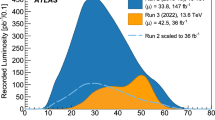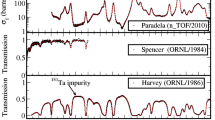Abstract
From the empirical phenomena of fragment distributions in nuclear spallation reactions, semiempirical formulas named SPAGINS were constructed to predict fragment cross-sections in high-energy \(\gamma\)-induced nuclear spallation reactions (PNSR). In constructing the SPAGINS formulas, theoretical models, including the TALYS toolkit, SPACS, and Rudstam formulas, were employed to study the general phenomenon of fragment distributions in PNSR with incident energies ranging from 100 to 1000 MeV. Considering the primary characteristics of PNSR, the SPAGINS formulas modify the EPAX and SPACS formulas and efficiently reproduce the measured data. The SPAGINS formulas provide a new and effective tool for predicting fragment production in PNSR.







Similar content being viewed by others
Data Availability Statement
The data that support the findings of this study are openly available in Science Data Bank at https://doi.org/10.57760/sciencedb.j00186.00319 and https://cstr.cn/31253.11.sciencedb.j00186.00319.
References
C.W. Ma, Y.G. Ma, Shannon information entropy in heavy-ion collisions. Prog. Part. Nucl. Phys. 99, 120 (2018). https://doi.org/10.1016/j.ppnp.2018.01.002
Q. Liu, Q. Normahmedov, M. Jing et al., Determination of cross-sections of natPb(p, x)207Bi and natPb(p, x) 194Hg by GeTHU. Nuclear Techniques 46, 090501 (2023). https://doi.org/10.11889/j.0253-3219.2023.hjs.46.090501
L. Liu, S. Niu, J. Zhu et al., Motion characteristics and laws of the debris from a near-space nuclear detonation. Nuclear Techniques (in Chinese) 45, 100503 (2022). https://doi.org/10.11889/j.0253-3219.2022.hjs.45.100503
S. Shibata, M. Imamura, T. Miyachi et al., Photonuclear spallation reactions in Cu. Phys. Rev. C 35, 254 (1987). https://doi.org/10.1103/PhysRevC.35.254
K. Strauch, Recent studies of photonuclear reactions. Annu. Rev. Nucl. Sci. 2, 105 (1953). https://doi.org/10.1146/annurev.ns.02.120153.000541
J.S. Levinger, Theories of photonuclear reactions. Annu. Rev. Nucl. Sci. 4, 1 (1954). https://doi.org/10.1146/annurev.ns.04.120154.000305
F.R. Metzger, Resonance fluorescence in nuclei. Prog. Nucl. Phys. 7, 53 (1959)
M. Danos, E.G. Fuller, Photonuclear reactions. Annu. Rev. Nucl. Sci. 15, 29 (1965). https://doi.org/10.1146/annurev.ns.15.120165.000333
U.E. Berg, U. Kneissl, Recent progress on nuclear magnetic dipole excitations. Annu. Rev. Nucl. Part. Sci. 37, 33 (1987). https://doi.org/10.1146/annurev.ns.37.120187.000341
U. Kneissl, H.H. Pitz, A. Zilges, Investigation of nuclear structure by resonance fluorescence scattering. Prog. Part. Nucl. Phys. 37, 349 (1996). https://doi.org/10.1016/0146-6410(96)00055-5
H.R. Weller, M.W. Ahmed, H. Gao et al., Research opportunities at the upgraded HIGS facility. Prog. Part. Nucl. Phys. 62, 257 (2009). https://doi.org/10.1016/j.ppnp.2008.07.001
A. Zilges, D.L. Balabanski, J. Isaak et al., Photonuclear reactions-From basic research to applications. Prog. Part. Nucl. Phys. 122, 103903 (2022). https://doi.org/10.1016/j.ppnp.2021.103903
R.H. Milburn, Electron scattering by an intense polarized photon field. Phys. Rev. Lett. 10, 75 (1963). https://doi.org/10.1103/PhysRevLett.10.75
F.R. Arutyunian, V.A. Tumanian, The Compton effect on relativistic electrons and the possibility of obtaining high energy beams. Phys. Lett. 4, 176 (1963)
C. Bemporad, R.H. Milburn, N. Tanaka et al., High-energy photons from Compton scattering of light on 6.0-GeV electrons. Phys. Rev. 138, 1546 (1965). https://doi.org/10.1103/PhysRev.138.B1546
H.W. Wang, G.T. Fan, L.X. Liu et al., Development and prospect of shanghai laser Compton scattering gamma source. Nucl. Phys. Rev. 37, 53 (2020). https://doi.org/10.11804/NuclPhysRev.37.2019043
H.W. Wang, G.T. Fan, L.X. Liu et al., Commissioning of laser electron gamma beamline SLEGS at SSRF. Nucl. Sci. Tech. 33, 87 (2022). https://doi.org/10.1007/s41365-022-01076-0
Y.W. Gong, M. Zhang, W.J. Fan et al., Beam performance of the SHINE dechirper. Nucl. Sci. Tech. 32, 29 (2021). https://doi.org/10.1007/s41365-021-00860-8
N.S. Huang, Z.P. Liu, B.J. Deng et al., The MING proposal at SHINE: megahertz cavity enhanced X-ray generation. Nucl. Sci. Tech. 34, 6 (2023). https://doi.org/10.1007/s41365-022-01151-6
S. Amano, K. Horikawa, K. Ishihara et al., Several-MeV gamma-ray generation at NewSUBARU by laser Compton backscattering. Nucl. Instrum. Methods Phys. Res. Sect. A 602, 337 (2009). https://doi.org/10.1016/j.nima.2009.01.010
D. Habs, T. Tajima, V. Zamfir, Extreme light infrastructure-nuclear physics (ELI-NP): new horizons for photon physics in Europe. Nuclear Phys. News 21, 23 (2011). https://doi.org/10.1080/10619127.2010.529741
A. Deppman, G.S. Karapetyan et al., Bremsstrahlung-induced fission and spallation of the pre-actinide nucleus \(^{181}{{\rm Ta}}\). Phys. Rev. C 91, 024620 (2015). https://doi.org/10.1103/PhysRevC.91.024620
B. Mei, D.L. Balabanski et al., Empirical parametrization for production cross sections of neutron-rich nuclei by photofission of \(^{238}{{\rm U}}\) at low energies. Phys. Rev. C 96, 064610 (2017). https://doi.org/10.1103/PhysRevC.96.064610
Guan-Lin. Wang, Hao-Yang. Lan et al., A general framework for describing photofission observables of actinides at an average excitation energy below 30 MeV. Chin. Phys. C 46, 084102 (2022). https://doi.org/10.1088/1674-1137/ac6abc
G. Andersson, I. Blomqvist, B. Forkman et al., Photon-induced nuclear reactions above 1 GeV: (I). Experimental. Nucl. Phys. A 197, 44 (1972). https://doi.org/10.1016/0375-9474(72)90744-0
G.G. Jonsson, K. Lindgren, Photon-induced nuclear reactions above 1 GeV: (I). Experimental. Phys. Scr. 7, 49 (1973). https://doi.org/10.1088/0031-8949/7/1-2/004
K. Lindgren, G.G. Jonsson, Photon-induced nuclear reactions above 1 GeV: (II). Spallation reactions. Nucl. Phys. A 197, 71 (1972). https://doi.org/10.1016/0375-9474(72)90745-2
G.G. Jonsson, B. Persson, High-energy photon induced spallation reactions in 127I. Nucl. Phys. A 153, 32 (1970). https://doi.org/10.1016/0375-9474(70)90755-4
R. Serber, Nuclear reactions at high energies. Phys. Rev. 72, 1114 (1947). https://doi.org/10.1103/PhysRev.72.1114
B. Bülow, B. Johnsson, M. Nilsson et al., Photospallation of 51V at intermediate energies. Zeitschrift für Physik A 278, 89 (1976). https://doi.org/10.1007/BF01547346
G. Rudstam, The evaporation step in spallation reactions. Nucl. Phys. A 126, 401 (1969). https://doi.org/10.1016/0375-9474(69)90475-8
M. Areskoug, B. Schrøder, K. Lindgren, Photofission in bismuth at intermediate energy. Nucl. Phys. A 251, 418 (1975). https://doi.org/10.1016/0375-9474(75)90538-2
A. Koning, S. Hilaire, S. Goriely, User Manual of TALYS-1.96 (2021). https://doi.org/10.1051/ndata:07767
O.S. Deiev, I.S. Timchenko, S.M. Olejnik et al., Cross-sections of photonuclear reactions \(^{65}\)Cu(\(^{65}\), n)\(^{64}\)Cu and \(^{63}\)Cu(\(\gamma\), xn)\(^{63?x}\)Cu in the energy range \(E_{\gamma \text{ max }}\) = 35–94 MeV. Chin. Phys. C 46, 124001 (2022). https://doi.org/10.1088/1674-1137/ac878a
G.G. Jonsson, K. Lindgren, A complementary study of photospallation systematics. Phys. Scr. 15, 308 (1977). https://doi.org/10.1088/0031-8949/15/5-6/004
G.G. Jonsson, K. Lindgren, Pion effects in \(^{127}\)I(\(\gamma\), xn) reactions of high multiplicity. Nucl. Phys. A 141, 355 (1970). https://doi.org/10.1016/0375-9474(70)90851-1
A.J. Koning, S. Hilaire, M.C. Duijvestijn, TALYS-1.0, ND 2007—International Conference on Nuclear Data for Science and Technology, April 22–27, Nice, France. ND2007:058 (2007). https://doi.org/10.1051/ndata:07767
A.J. Koning, J.P. Delaroche, Local and global nucleon optical models from 1 keV to 200 MeV. Nucl. Phys. A 713, 231 (2003). https://doi.org/10.1016/S0375-9474(02)01321-0
D.G. Madland, Meeting on the nucleon-nucleus optical model up to 200 MeV. Bruyeres-le-Chatel, France, November 13–15 (1996). arXiv:nucl-th/9702048
A. Koning, S. Hilarie, S. Goriely, Manual for TALYS 1.96, pp. 75–80
G. Rudstam, Systematics of spallation yields. Zeitschrift für Naturforschung A 21, 1027 (1966). https://doi.org/10.1515/zna-1966-0724
S.G. Rudstam, XLII. Spallation of elements in the mass range 51–75. Philos. Mag. J. Sci. 46, 344 (1955). https://doi.org/10.1080/14786440308521088
R. Silberberg, C.H. Tsao, Partial cross-sections in high-energy nuclear reactions, and astrophysical applications I targets with z \(<= 28\). APJ Suppl. Ser. 25, 315 (1973). https://doi.org/10.1086/190271
K. Sümmerer, B. Blank, Modified empirical parametrization of fragmentation cross sections. Phys. Rev. C 61, 034607 (2000). https://doi.org/10.1103/PhysRevC.61.034607
K. Sümmerer, Improved empirical parametrization of fragmentation cross sections. Phys. Rev. C 86, 014601 (2012). https://doi.org/10.1103/PhysRevC.86.014601
C. Schmitt, K.-H. Schmidt, A. Kelić-Heil, SPACS: a semi-empirical parameterization for isotopic spallation cross sections. Phys. Rev. C 90, 064605 (2014). https://doi.org/10.1103/PhysRevC.90.064605
C. Schmitt, K.-H. Schmidt, A. Kelić-Heil, Erratum: SPACS: a semi-empirical parameterization for isotopic spallation cross sections [Phys. Rev. C 90, 064605 (2014)]. Phys. Rev. C 94, 039901 (2016). https://link.aps.org/doi/10.1103/PhysRevC.94.039901
K. Sümmerer, W. Brüchle, D.J. Morrissey et al., Target fragmentation of Au and Th by 2.6 GeV protons. Phys. Rev. C 42, 2546 (1990). https://doi.org/10.1103/PhysRevC.42.2546
K. Sümmerer, Erratum: Improved empirical parametrization of fragmentation cross sections [Phys. Rev. C 86, 014601 (2012)]. Phys. Rev. C 87, 039903 (2013). https://link.aps.org/doi/10.1103/PhysRevC.87.039903
R.K. Tripathi, F.A. Cucinotta, J.W. Wilson, Accurate universal parameterization of absorption cross sections. Nucl. Instrum. Methods Phys. Res. Sect. B 117, 347 (1996). https://doi.org/10.1016/0168-583X(96)00331-X
R.K. Tripathi, J.W. Wilson, F.A. Cucinotta, Accurate universal parameterization of absorption cross sections II—neutron absorption cross sections. Nucl. Instrum. Methods Phys. Res. Sect. B 129, 11 (1997). https://doi.org/10.1016/S0168-583X(97)00121-3
S.R. Sarkar, M. Soto, Y. Kubota, Photospallation of complex nuclei at intermediate energies. I. Radiochimica Acta 55, 113 (1991). https://doi.org/10.1524/ract.1991.55.3.113
Author information
Authors and Affiliations
Contributions
All authors contributed to the study conception and design. Material preparation, data collection, and analysis were performed by Hui-Ling Wei, Pu Jiao, Yu-Ting Wang, Jie Pu, Kai-Xuan Cheng, Ya-Fei Guo, Chun-Yuan Qiao, Gong-Tao Fan, Hong-Wei Wang, and Chun-Wang Ma. The first draft of the manuscript was written by Meng-Die Zhou, and all authors commented on the previous versions of the manuscript. All authors read and approved the final manuscript.
Corresponding author
Ethics declarations
Conflict of Interest
Chun-Wang Ma is an editorial board member for Nuclear Science and Techniques and was not involved in the editorial review or the decision to publish this article. All authors declare that there are no competing interests.
Additional information
This work was supported by the Program for Innovative Research Team (in Science and Technology) in University of Henan Province (No. 21IRTSTHN011), China.
Appendices
Appendix I: SPAGINS formulas
Many SPACS and EPAX formulas are incorporated into the SPAGINS formulas. Owing to the definition of the individual parameters in the formula, SPAGINS adopts gamma quanta as the target. To present the SPAGINS formula more clearly, detailed formulas are provided in this section.
For a fragment with mass and charge numbers (A, Z), the production cross-section in PNSR is
For the first term, the reaction cross-section is
where \(r_0=\) 1.1 fm, and
One can determine \(r_\text {proj}=1.29r_\text {proj}^\text {rms}\), and \(r_\text {proj}^\text {rms}=0.891A_\text {proj}^{\frac{1}{3}} \left( 1+5.565A_\text {proj}^{-\frac{2}{3}}-1.04A_\text {proj}^{-\frac{4}{3}}\right)\). \(r_\text {tar}^\text {rms}=\) 0.85.
where
and
For \(A_\text {proj}<\) 200,
in which,
and
For the second term, the mass distribution considers the contributions from the central (\(Y(A)_\text {cent}\)) and peripheral collisions (\(Y(A)_\text {prph}\)),
When considering the incident energy dependence of the mass yield,
where G is sorted into the following three regions:
The contribution of central collisions to a specific fragment cross-section is
where
The contribution of peripheral collisions to a specific fragment cross-section is
where
The third term \(\sigma (A,Z)\) is parameterized by the number of neutron- and proton-rich fragments. For neutron-rich ones,
and proton-rich
\(Z_\text {prob}\) and \(Z_{\beta }\) take the form of
For a neutron-rich projectile,
For proton-rich projectiles,
in which \(\Delta =\Delta _5A^2\), \(\Delta ^{'}=\Delta [1+d_1(A/A_\text {proj}-d_2)^2]\), \(n=\sqrt{R/\pi }\), and \(R=R_{0}^\text {n,p}R^\text {phy}\).
For neutron-rich spallation targets,
For a proton-rich spallation target,
One also has,
For neutron-rich fragments,
and proton-rich fragments.
The brute force factors \(f_\text {n}\) presented in Sect. 6.
Appendix II: brute force factor
The “brute force factor” in Eqs. (9) and (10) was parameterized according to the incident energy of the reaction and different ranges of fragment charge numbers. For the energy range of 100 MeV \(\le E_\gamma<\) 220 MeV, when \(Z\le 26\),
where
when \(Z>26\),
For the incident energy range of 220 MeV\(\le E_\gamma<\) 500 MeV, when the charge of the fragments \(Z\le 21\),
when \(21<Z\le 26\),
when \(Z>26\),
For the incident energy range of 500 MeV \(\le E_\gamma \le\) 1000 MeV, when \(Z\le 21\),
when \(21<Z\le 26\),
and when \(Z>26\),
where parameters from Eqs. (3) to (48) can be found in Refs. [46, 47].
Rights and permissions
Springer Nature or its licensor (e.g. a society or other partner) holds exclusive rights to this article under a publishing agreement with the author(s) or other rightsholder(s); author self-archiving of the accepted manuscript version of this article is solely governed by the terms of such publishing agreement and applicable law.
About this article
Cite this article
Wei, HL., Zhou, MD., Jiao, P. et al. SPAGINS: semiempirical parameterization for fragments in gamma-induced nuclear spallation. NUCL SCI TECH 34, 190 (2023). https://doi.org/10.1007/s41365-023-01342-9
Received:
Revised:
Accepted:
Published:
DOI: https://doi.org/10.1007/s41365-023-01342-9




